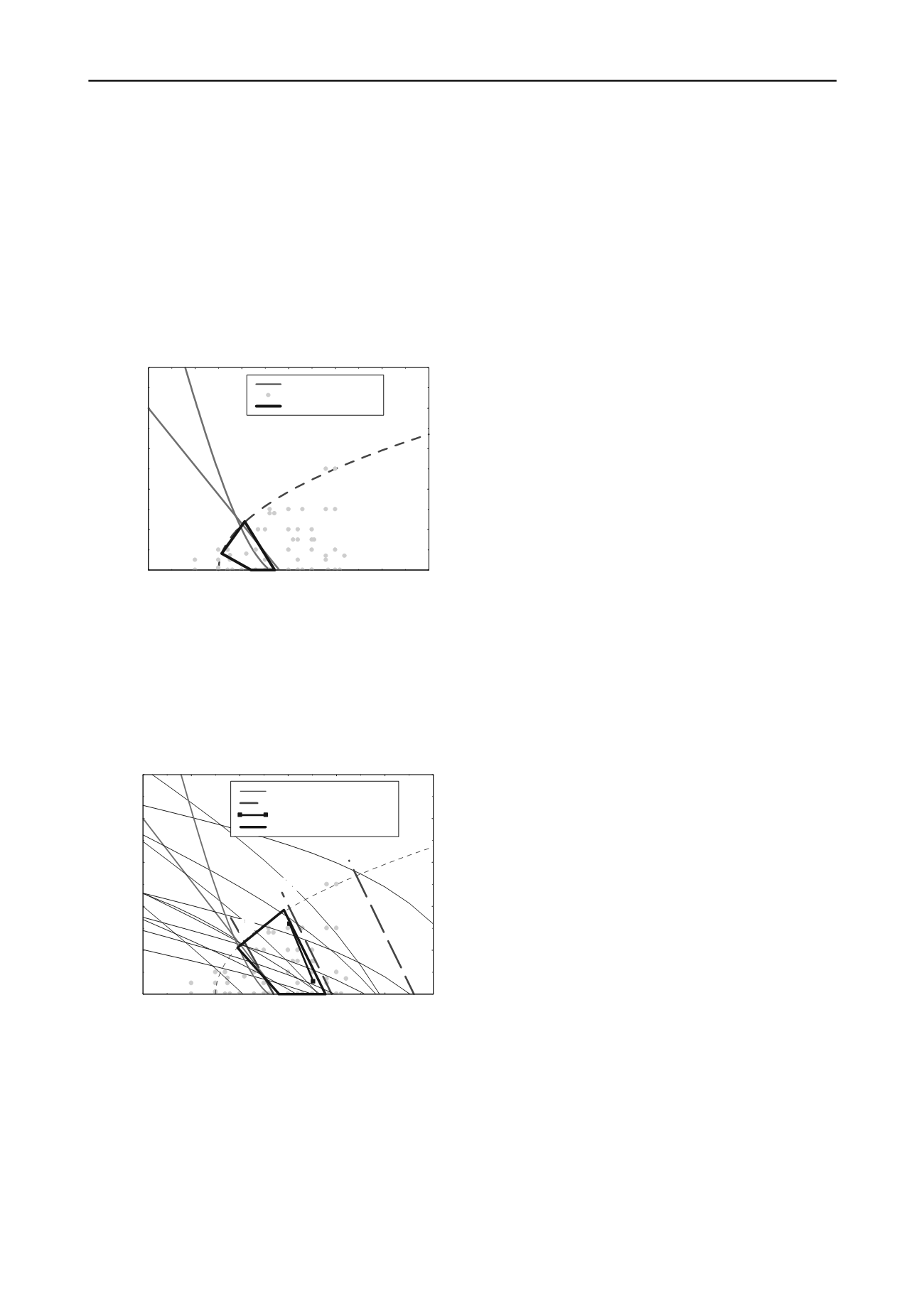
3008
Proceedings of the 18
th
International Conference on Soil Mechanics and Geotechnical Engineering, Paris 2013
Regarding the back-analysis of failures, the uncertainties
commented above limit their use.
One of the first proposals was due to Singh and Murphy
(1990), but with no attempt to reduce the wide ranges of
cohesion and friction resulting from real failures.
Based on the limited data available at the time, Sánchez et
al. (1993) proposed a joint consideration of the results of
laboratory and in situ tests and back-analysis of failures. The
first ones gave a set of pairs of values of cohesion and friction,
increasing with the strain. The real failure cases help to identify
the relevant strain level, and reciprocally, the lab tests help to
identify the real c/
ratio. In situ tests can also give information
on that respect. The result is shown in Figure 5.
0
20
40
60
80
100
0
10
20
30
40
50
60
Back analyses (by 1990)
Lab tests (by 1990)
Sánchez et al. (1993)
Friction angle,
(
o
)
Cohesion, c (kPa)
Figure 5. Strength parameters. Early design recommendations (Sánchez
el al., 1993)
In the last two decades, some additional results have been
published, from laboratory and in situ tests and from real
failures (see, for instance, the compilation by Stark et al. (2009),
among others). Considering these data, the recommended values
in Figure 5 can be increased. Figure 6 includes the results of
failures compiled by Stark et al. (2009), and their recommended
values, based on the proposal by Eid et al. (2000).
0
20
40
60
80
100
0
10
20
30
40
50
60
Back analyses (by 2009)
Strain levels (Stark et al., 2009)
Stark et al. (2009)
Possible new proposal
5%
10%
20%
Friction angle,
(
o
)
Cohesion, c (kPa)
Figure 6. Additional data. Modifications to Figure 5.
5 CONCLUSIONS
Prior work has shown that it is no easy to obtain the mechanical
properties of the waste mass.
After merging the data from the revision of existing
bibliography and the experience of the U.C. Geotechnical
Group, new research is being undertaken in order to establish a
method to perform that task during the next three years. The
study will be based on the use of field tests, complemented with
medium to large scale laboratory direct shear tests. It will cover
several landfills, with conventional MSW, together with wastes
subjected to mechanical and biological pre-treatment (MBT),
introduced in Spain in the last years (projects GEORES-
03.2843.64001 and PROMERSU-BIA2012-34956).
The study will be performed in several landfills. In parallel
with the test campaign, numerical modelling of the landfills
under study will be undertaken to obtain feedback and refine the
data acquisition process.
After all the data are gathered and the process is considered
optimum, a method to obtain the mechanical properties of a
landfill using field tests and a new proposal for the design
strength parameters will be obtained as a result of the research.
6 REFERENCES
Bray, J.D., Zekkos, D., Kavazanjian, E., Athanasopoulos, G.A. and
Riemer, M. F. 2009. Shear strength of municipal solid waste.
Journal of Geot. and Geoenv. Eng
.. ASCE 135(6),709-722.
Caicedo, B., Yamin, L., Giraldo, E. and Coronado, O. 2002.
Geomechanical properties of municipal solid waste in Doña Juana
sanitary landfill.
Proc. 4
th
Env. Geotechnics – 4
th
ICEG
, Rio de
Janeiro 1,177-182.
Dixon, N. and Jones, R. 2005. Engineering properties of municipal solid
waste.
Geotextiles and Geomembranes
23,205–233.
Dixon, N., Whittle, R.W., Jones, D.R. V. and Ng’ambi, S. 2006.
Pressuremeter tests in municipal solid waste: measurement of shear
stiffness.
Géotechnique
56(3),211–222.
Eid H, Stark T.D., Evans W.D. and Sherry P. 2000. Municipal solid
waste slope failure I: Waste and foundation properties.
Journal of
Geot. and Geoenv. Eng.
. ASCE 126(5),397-407.
Grisolia, M. and Napoleoni, X. 1996. Geotechnical characterization of
municipal solid waste: choice of design parameters.
Proc. 2nd Int.
Cong. on Env. Geotechnics
, Osaka, Japan 2,641–646.
Huvaj-Sarihan, N. and Stark, T.D. 2008. Back analyses of landfill slope
failures.
VIth Int. Conf. on Case Histories in Geot. Eng. and Symp.
in Honor of Prof. James K. Mitchell
. Paper 2.34.
Jessberger, H.L. and Kockel, R. 1993. Determination and assessment of
the mechanical properties of waste materials.
Proc. Sardinia 93, 4th
Int. landfill Symp.
, Cagliari, Italy,1383–1392.
Kavazanjian, E. 2003. Evaluation of MSW properties using field
measurements”.
Proc.17th GSI/GRI Conf.
Las Vegas, USA.74-113.
Machado, S. L., Carvalho, M.F. and Vilar, O.M. 2002. Constitutive
Model for Municipal Solid Waste.
Journal of Geot. and Geoenv.
Eng
. ASCE. 128(11),940-951.
Palma, J. 1995.
Comportamiento geotécnico de vertederos controlados
de residuos sólidos urbanos
. PhD Thesis. Univ. of Cantabria.
Sánchez, J.M., Palma, J., Sagaseta, C. and Cañizal, J. 1993. Mechanical
properties of wastes in a sanitary landfill.
Waste Disposal by
Landfill. (R.W. Sarsby, ed.)
. Bolton, U.K. 357-364.
Singh, S., and Murphy, B. 1990. Evaluation of the stability of sanitary
landfills.
Geotechnics of Waste Fills — Theory and Practice
,
ASTM STP1070,240–258.
Sivakumar Babu, G.L., Reddy, K.R. and Chouksey, S.K. 2010.
Constitutive model for municipal solid waste incorporating
mechanical creep and biodegradation-induced compression”.
Waste
Management
30,11–22.
Sowers, G.F. 1968. Foundation problems in sanitary landfills.
Journal
of the Sanitary Div
., ASCE 94(SA1),103-116.
Stark, T., Huvaj-Sarihan, N. and Li, G. 2009. Shear strength of
municipal solid waste for stability analyses.
Environ Geol.
57,1911–1923.
Withiam, J.L., Tarvin, P.A., Bushell, T.D., Snow, R.E. and Germann,
H.W. 1995. Prediction and performance of municipal landfill slope.
Proc. Int. Conf. Geoenv. 2000
, GSP46, ASCE, New Orleans,
Lousiana, 2,1005-1019.
Zekkos, D., Athanasopoulos, G. A., Bray, J. D., Grizi, A. and
Theodoratos, A. 2010. Large-scale direct shear testing of municipal
solid waste.
Waste Management
30(8-9),1544-1555.
Zhan, L.T., Chen, Y.M., Ling, W.A. 2008. Shear strength
characterization of municipal solid waste at the Suzhou landfill,
China.
Eng. Geol
. 97,97-111.


